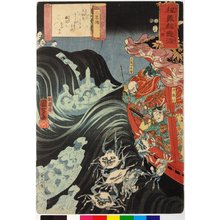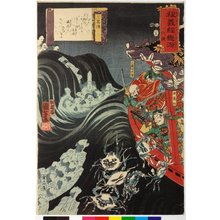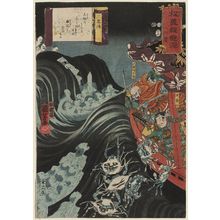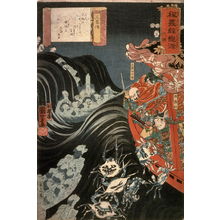歌川国芳による浮世絵「Yoshitsune and Heike Goblins」
作者:歌川国芳
作品名:Yoshitsune and Heike Goblins
制作年:1853
詳細:詳細情報...
情報源:ホノルル美術館
浮世絵(全 5,476 件)を表示...
説明:
After leading the Genji clan to victory over the Heike, Yoshitsune was held in considerable esteem by his generals and wielded significant political power. His brother Yoritomo, the head of the Genji clan, feared Yoshitsune would lead a rebellion against him, and ordered him killed. Yoshitsune was forced to flee the capital in Kyoto with just a handful of retainers and seek shelter from loyal friends. In the scene depicted here, Yoshitsune and his retainers try to flee from his brother's assassins by boat across the strait at Daimotsu no Ura near present-day Osaka, but are blocked by a fierce storm. Yoshitsune had won the final, decisive battle of the Genpei war in the strait of Dan no Ura, and many Heike warriors drowned in its waters. Now, as Yoshitsune tries to escape by boat, ghosts of the drowned Heike warriors try to take their revenge during the storm. Benkei, who in many ways has become the central figure of the Yoshitsune story by this point, is able to draw on his training as a monk to say prayers that ward off the ghostly horde. Among Benkei's defining features are his quick wit and his mastery of many skills, military, religious and literary, which allow him to respond effectively to any situation, even when his master loses hope or is incapable of responding appropriately, as shown in this scene. He is often depicted with a multitude of tools on his back, symbolizing his numerous skills and tricks (see also Ushiwakamaru and Benkei on display nearby). Some of the ghosts are depicted as crabs, a reference to a species of crab known as heikegani (Heikea japonica), which to this day live in the waters of Dan no Ura and have patterns on their shells resembling human faces. They are said to be reincarnations of the Heike warriors who died there. The use of black ink to depict the roiling, stormy sea is quite distinctive. Also of note is the wood grain, visible in the sky. ALT TEXT The 1185 Battle of Dannoura was the last battle of the Heike Monogatari (The Tale of the Heike) and takes place in the Straits of Shimonoseki, where the Heike (Taira) clan and the Minamoto (Genji) clan engage in a bitter battle. The Taira clan perishes in this dramatic finish in which everyone-men, women and children-dies. Legend has it that the tragedy of their demise lingers, and the area is considered haunted by Heike crabs which have human faces on their backs and are thought to be the spirits of dead Heike warriors. Kuniyoshi makes every effort to depict the frightening crabs and haunted spirits of the deceased in his powerful image of this final battle. Minamoto Yoshitsune, accompanied by his faithful retainer Benkei, conquers his enemies amid a roiling sea, an action which gives birth to numerous legends and tales. In Kuniyoshi's day, the sea, teeming with these crabs, was reputedly calmed by the erection of a Buddhist temple on the nearby shore, as well as by shrines to the deceased. This imagery has inspired contemporary American tattoo and print artist Don Ed Hardy, among others. (Tattoo exhibition 2005)




